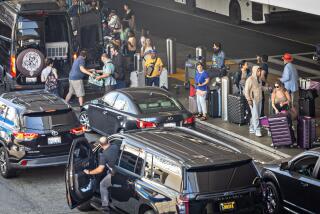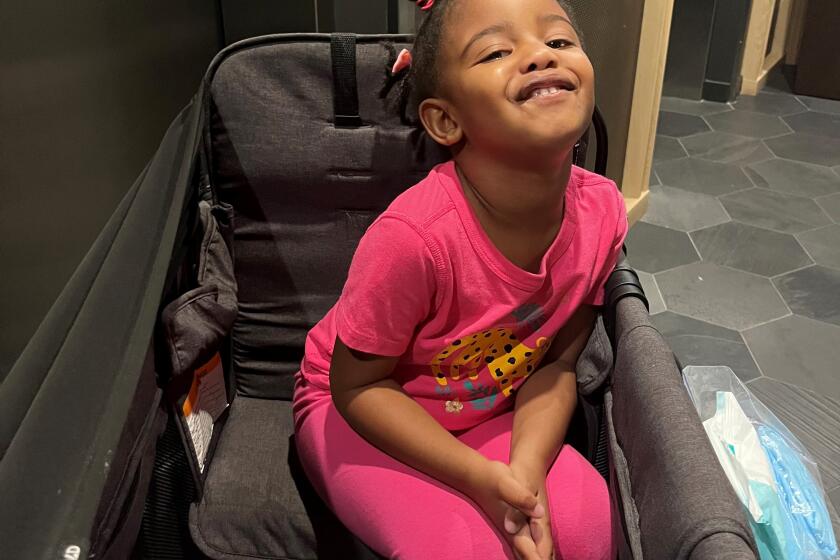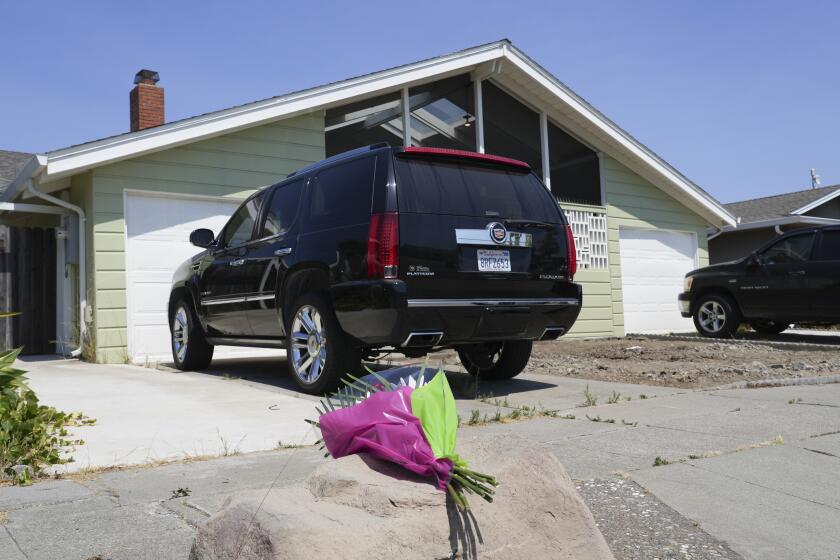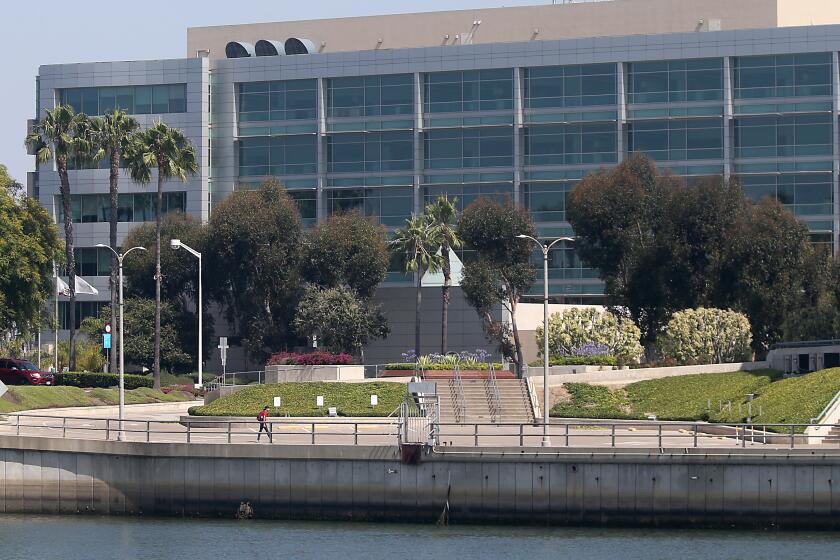COLUMN ONE : ‘Smile, You’re in America’ : Korean Americans, devastated by the riots, take lessons on sensitivity and acculturation.
With the zeal of an evangelist and humor of a comic, Byung Sik Hong travels around Los Angeles and Orange counties urging Korean immigrants to put on a happy face and smile.
“Practice smiling every chance you get,” advises Hong, a Korean American management expert and volunteer cultural sensitivity trainer. “Even if you speak broken English, you can still convey friendliness with a smile, a firm handshake or a pat on the back.”
He tells immigrants who come from a culture where bowing, not handshaking is the rule, to shake hands often, and to “squeeze” the hand while looking people directly in the eye. Koreans have a tendency to drop their hand like a “dead fish,” he says. “Who wants to touch a dead fish?”
Since the 1992 riots--the most traumatic event in the collective experience of 1 million Koreans in the United States--a lot of effort has gone into helping immigrants avoid the behavior that is often misinterpreted by those unfamiliar with their culture.
To be sure, many factors contributed to the targeting of Korean American-owned businesses during the riots. Korean community leaders readily acknowledge that unpleasant encounters had occurred between Korean shopkeepers and their customers. But, they believe, the negative media portrayal of Korean shopkeepers as rude and uncaring people--without adequate response from Korean proprietors--was the main reason why Koreans were singled out in the looting and firebombing during the riots.
Though they feel strongly that this media-reinforced stereotype was unfair, their frustration has propelled thoughtful Korean Americans to come together to try to climb over the cultural wall that has made Koreans perhaps the most misunderstood of Asian immigrants.
“When you get to know Koreans, you’ll find them compassionate, kind and loyal,” said Hong. But Koreans neither toot their horn nor go out of their way to make it easy for outsiders to get to know them, he says.
In churches, social and professional gatherings and in the Korean-language news media, there has been considerable talk about the nexus between acculturation and the future of Koreans in Los Angeles, the city with the biggest Korean population outside Asia.
Two and a half years after the riots, “Smile, you’re in America” has become a new mantra for Koreans, having replaced the one of “Work, work, work.”
“The riots taught us it is not enough to work hard,” said economist Ky Chuoen Kim, president of the nonprofit Korean American Management Assn., which offers classes to help immigrant entrepreneurs acculturate and acquire business savvy. “You need to work hard but you also have to be culturally sensitive and know American business practices.”
From the Koreatown studios of Radio Korea and FM-Seoul, Kim and Hong offer daily lessons on how to succeed in America by changing.
During a recent broadcast, Hong counseled Korean American shopkeepers to greet their customers as they would visiting relatives from South Korea. If they wait for customers to pay for their purchases, and plunk down the change on the counter without being attentive, they are sure to engender bad feelings, Hong said.
“They feel insulted when someone just puts the change on the counter,” said Hong, 61, who has worked 30 years for major U.S. companies, including Hughes Aircraft. A devout Mormon who lives in Mission Viejo, Hong sees his present work as God’s calling.
Public service announcements on local Korean television and radio stations also remind immigrants that they live in multicultural America, not monocultural Korea, and that they should learn English.
“In multiethnic L.A., we need to adjust our thinking and behavior,” said one radio spot, imploring Korean Americans to try to be friendly when interacting with people of other races.
No one knows just how effective the campaign has been. But indications that the drive is having results are visible even in such unlikely places as MTA buses.
On a midsummer afternoon, three elderly Korean women stepped on the No. 28 bus headed Downtown from Koreatown. As they showed their monthly senior passes, the women smiled and thanked the driver. Their thank yous came out “tank q” and their smiles appeared a bit awkward, but the goodwill apparent in the gestures registered with the black driver, who reciprocated with a smile of his own, and “You’re welcome.”
*
Smiling, saying “hello” and shaking hands may be natural to most Americans, but they are not for Korean immigrants in whose culture a smile and small talk are usually reserved for friends and families--and from their point of view, not to be squandered on strangers.
For the first generation, especially those arriving here after age 30, it is tough to change their ways, said the Rev. Hee-Min Park, senior pastor of Youngnak Presbyterian Church of Los Angeles, who often injects the value of acculturation in his sermons to 5,000 worshipers each Sunday. “Koreans--especially the men--were brought up not to be expressive,” he said.
Though displaying emotions may not be a virtue in his culture, businessman Jimmy Park has taken to heart the old adage about doing what Romans do when you’re in Rome.
Park, proprietor of a South-Central liquor store, has long tried to blend in--at times even talking like some of his customers, four-letter words and all. He smiles and talks to anybody who walks into his shop.
“Hi, buddy, what’s you doin’?” he greets regulars with a big smile.
Park says Koreans definitely should smile more and lower their voices. “Koreans have loud voices,” he said. That, combined with dour faces and limited English, can lead to miscommunication.
His customers like Park’s business style, but he is glad his wife does not work at the store and see him smile so much.
“An (inappropriate) smile, in the parlance of Korean culture, equals shallowness and thoughtlessness,” said Korean American commentator K.W. Lee, who has lived in the United States for nearly half a century.
That is why, Lee noted, it is so rare to see photos of smiling cabinet members, church ministers or community leaders in Korean language newspapers or on TV because people in those positions are expected to project a serious and dignified image.
The impassive traits of Korean American shopkeepers doing business here can send a wrong message--and even be misconstrued as racism.
Behavioral scientist Thomas J. Knutson depicted a typical scenario to illustrate how that can happen in transactions with black customers:
“When an African American enters a store, that person is expecting some sort of eye contact and pleasantry. When a Korean American shopkeeper, reluctant to develop friendship with a stranger, doesn’t provide that, an African American may think the store owner is being disrespectful or rude.”
By the same token, he said, a Korean American might see the more outgoing style of the African American as inappropriate and, sometimes, threatening.
To Korean immigrants, indoctrinated in a highly structured Confucian culture in which formality is stressed, some of the informal behavior of American youths offends their sensibilities.
“Koreans very much mind manners,” said Korean American philosopher Chin-Tae Kim, of Case Western Reserve University in Cleveland. “They regard other groups as totally lacking in manners.”
But sensibilities, like aesthetics, are in the eye of the beholder.
All too often African American criticisms of Korean merchants are identical to those Koreans have about black customers, said Larry Aubry, a human relations specialist who has spent years trying to bring together black and Korean American communities in Los Angeles.
“It’s almost as if you take the same thing (that they are arrogant, rude, aggressive and disrespectful) and ask Koreans and they say the same thing about African Americans--except they would add that young ones tend to steal,” Aubry said.
He does not want to minimize the value of Koreans striving to become more culturally sensitive, he says, but adds that they are naive if they think that will solve the problem.
“There is a basis for all of the hostility . . . that just pours out of the African American community,” he said, referring to the racism blacks historically have faced in this country.
Nothing short of a national “political will” to eliminate institutionalized racism against blacks can solve that, Aubry said, and Korean immigrants should know that.
*
A motorist driving through Koreatown may not notice it, but walk inside the area’s many mini-malls and shopping centers and one can see how much has changed since the riots. Koreatown entrepreneurs have been putting up scores of English store signs where previously only Korean signs were displayed.
Entrepreneurs are also flocking to English and Spanish language classes to better relate to their non-Korean customers.
To date, more than 500 business people have taken sensitivity training to learn U.S.-style communication skills being offered by the Korean American Management Assn.
Every Thursday evening about 120 people show up for a three-hour seminar designed to help them not only understand American ways but to develop their mom-and-pop operations into mainstream businesses. The 18-week session, at the Radisson Wilshire Plaza Hotel in Koreatown, provides courses in U.S. law, government, histories of blacks and Latinos, and business practices.
The program is in such demand it keeps Ky Chuoen Kim hopping to bring in lecturers--almost all of them U.S.-educated Korean American professors, lawyers and business experts. Some come from as far away as Texas and New York, donating their time and expertise.
Ho K. Gum, who completed the program in August, says it has helped him better manage his Mission Hills store.
“Since the training, I’m mindful not only about my relationship with customers but my employees’ relationship and the customers too,” Gum said. “I’m always reminding my employees to smile and to go out of their way to be cordial.”
And because of the class, he now has a filing system at his business. “When a bill collector bills me twice, I can pull out the evidence right out of my files,” he said.
Maintaining a filing system may be a normal business practice for some, but it never occurred to him, said Gum, who was a civil engineer in Seoul. “I was running my business like a small corner shop in Korea.”
During one recent class, lecturer Yong Hwan Ryu, a specialist on international business, drew a picture of a potted pine tree to illustrate a lesson.
“The Korean American community is just like this tree,” he said. “Unless we get out of the pot and grow our roots deep into the soil, we will never become part of America.”
Lessons in acculturation include basic constitutional concepts, such as the presumption of innocence until proven guilty, and that all people are created equal--which Americans usually take for granted but are foreign to Korean immigrants.
To the first generation steeped in Confucianism, all people definitely are not equal: Men are superior to women. The young must respect the old. Education, pedigree, age, social and professional positions and titles all count.
The idea of the accused being presumed innocent until proven guilty is hard for Korean immigrants to accept, especially when one has witnessed a crime. In Korea, a person caught shoplifting can be roughed up by anyone. But here, that could result in charges of battery and assault.
The idea of extending respect to children, especially those who misbehave, is almost impossible for traditional Koreans. Koreans pamper their children but youngsters are expected to obey their elders.
Tae-Suk Kim, who operates a market in a racially mixed San Fernando Valley neighborhood, says he has had to train himself to conform to the American way.
“No matter how young they are, in America, you have to treat them civilly,” Kim said.
“I have kids who buy batteries from my store, use them all day in their boomboxes and come back on the following day, complaining that the batteries were defective,” Kim said.
If that happened in South Korea, a store owner could give the youngsters a good scolding and send them away. But Kim has learned to hold his tongue and write it off as another cost of doing business in a society where, he said, it seems that only wrongdoers have any rights.
America is not the place most Koreans had thought it would be.
“Korean immigrants come here knowing very little about the country,” said Edward Chang, a UC Riverside ethnic studies professor who teaches black and Latino histories in the sensitivity seminar.
Chang agrees with Aubry that poverty and alienation will require a national political will to resolve, but in the meantime, he says, Koreans need to continue their learning process and get out of their insulated world.
“The Korean community is very internal,” said Ramona Cortes Garza, director of community relations at UCLA, who has worked with Korean American groups.
She noted that many Latinos perceive Koreans as “aggressive,” and “very driven”--something Koreans find puzzling because they consider hard work to be one of their cherished traits.
“There is a cultural thing,” said political scientist Fernando Guerra, chairman of Chicano studies at Loyola Marymount University. “Mexicans and (other) Latin Americans have prided themselves in not only working hard but also knowing when to relax. We’re saying (to Koreans), ‘Hey, relax.’ ”
Accusations that Korean shopkeepers charge too much are unfair, Guerra says, because it is the nature of small businesses, not the ethnicity of owners, to charge more. But it is easy to attribute that to ethnic differences instead of economic reality, he said.
“People don’t realize how difficult it is to work in South-Central,” said Gum, whose first store was located there. “My life was on the line every day.”
For ethnic Koreans in the United States--85% of whom are immigrants--the trans-cultural journey has been an unending travail because of the cultural baggage they carry.
In that context, as devastating as the riots were, they did help push the Korean American community further toward Americanization.
“It took the riots to free Koreans from their cultural Teflon,” said commentator Lee. Until the riots’ assault on their lifestyle, he said, American ways simply did not “stick.”
With their world shattered, Korean immigrants have embarked on a new journey to cross over some of the old cultural barriers that have eluded so many of them in the past.
More to Read
Start your day right
Sign up for Essential California for news, features and recommendations from the L.A. Times and beyond in your inbox six days a week.
You may occasionally receive promotional content from the Los Angeles Times.






